Overview
Botball's mantra is that “Today’s Botball kids are tomorrow’s scientists and engineers.” [2] The program is managed by the non-profit KISS Institute for Practical Robotics (KISS stands for the engineering acronym: Keep It Simple Stupid) whose vision is to use robotics "to stimulate and engage students in exploring their potential in engineering, science and math." [3] The goal of Botball and KISS to educate the workforce of the future and to engage students in science, technology, engineering and math. This objective is shared by the NASA Robotics Alliance Project (RAP) which partners with Botball and other robotics education programs. NASA RAP's mission is “to enable the implementation of future robotic space exploration missions.” NASA sponsors Botball through providing technical mentors and other resources. [4] It also hosts an online free course in Programming robots in C, featuring a controller that was used in Botball [5] NASA RAP sees Botball as an opportunity to reach out to its future workforce and provide relevant hands-on experience and necessary skills to potential future NASA scientists. [6]
Botball is known for the sophistication and complexity of its robotic competitions. What differentiates Botball from other student robotics programs is that the robots are autonomous; therefore, they are not directed by remote control. Students use computer science to program the robots to recognize challenges and then attempt the objectives of the competition. The robots contain several types of sensors and also two digital cameras for their computer vision systems. [7] Robot Magazine, highlighted in an article the gameplay and systems, "Every year the game offers different challenges at varying levels of difficulty, so participants can focus on harder goals, or find simpler solutions, based on their abilities ... Botball uses the CBC2, a powerful robot controller that easily interfaces with a large number of sensors and effectors and features an ARM 9-based CPU/Vision processor running LINUX, an ARM 7-based DAQ/Motor control system, and integrated display and touch screens that are easy to use. The CBC2 uses the KISS-C Integrated Development Environment and its libraries, especially designed to be friendly to users with vastly different programming experience. Both the CBC2 and KISS-C were developed by KISS Institute and are used in university research programs, as well as the Botball Program." [8]
Botball competitions revolve around using autonomous robots to complete a series of tasks (such as collecting objects and moving them to another location or recognizing certain color objects and sorting them) within a set time limit of two minutes. Sensors and digital cameras give input to the robots, which help to identify objects. Beforehand and between rounds of competition, participants program the robots using an integrated development environment (KISS-C is the latest version). Botball competitors also must complete online documentation of their progress and their goals to score points.
A similar competition for adults, called the KIPR Open (formerly Beyond Botball), commenced in 2001. [9]
The Botball season/Competition
The Botball regional season runs from late January to about early May. During this time, students attend a two-day workshop and are trained in learning the basics of computer programming. Students have six to eight weeks to program, build, and test their robots. As the robots progress, students have to document how their robot is coming along as well as the tweaks and changes they made from the original design. During the regional competition, there are three rounds: Seeding, Double Eliminations, and Alliance. Seeding: Seeding is where one team goes against themselves(it is more like a practice round) but students still earn points and there is an award for the team that scores the highest on the seeding round. Double Eliminations is where the actual competition begins and where teams compete against each other until they are eliminated twice. Alliance Matches are matches for teams who have been eliminated twice early in the competition. Two teams are paired up together and they compete for points(it works like the seeding rounds but there is 1 individual team on each side and they try and score points as an alliance.)
Regions and international competitions
As of 2012, the regions in the United States are as follows:
Botball also had 4 tournaments [12] [13] in the Middle East:
As of 2011, Botball also had tournaments in
Starting in 2001, KIPR began holding a national competition and in 2003 the first international team participated. The international competition is held during the summer after all of the regional competitions have completed. Every team that participates in a regional competition is eligible to participate in the international competition. The game rules at the international competition are generally identical to that year's regional game. The event is held during the GCER (Global Conference for Educational Robotics). The KIPR Open (formerly Beyond Botball) is also held at GCER and multiple speakers come and talk about the robotics field. GCER has been hosted in Hawaii; Northern and Southern CA; Norman, OK; Jacksonville, FL; Leesburg, VA; and Edwardsville, IL, and Washington DC. In 2013, GCER will be held in Norman, OK.

Lego Mindstorms was a hardware and software structure which develops programmable robots based on Lego building blocks. Each version includes computer Lego bricks, a set of modular sensors and motors, and parts from the Lego Technic line to create the mechanical systems. The system is controlled by the Lego bricks.
The XBC, or the Xport Botball Controller, is a robot based on Charmed Labs' Xport hardware. It was built specifically for the Botball competition and uses a Game Boy Advance for its display and for high-level processing; a field-programmable gate array is used to offload low-level processing of motors and sensors from the Game Boy Advance. The XBC is programmed using Interactive C, which is a variant of the C programming language. The XBC replaced the RCX in 2005 as Botball's official processor. The RCX can be programmed using Interactive C, Not Quite C, or Lego's simple GUI interface. Both robots can have bases built with Lego pieces.
RoboCup Junior (RCJ), sometimes stylised RobocupJunior, is a division of RoboCup, a not-for-profit robotics organisation. It focuses on education and aims to introduce the larger goals of the RoboCup project to primary and secondary school aged children. Participants compete in one of three main leagues: Soccer, Rescue or Dance. Dance Theatre also exists as a sub-league of Dance, and Premier Rescue is part of the competition in Australia and New Zealand.
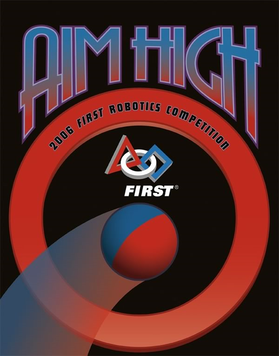
Aim High was the 2006 game for the FIRST Robotics Competition. The competition involved teams competing to gain points by delivering balls into goals and positioning their robots in certain positions on the playing field. The teams took it in turn to provide defense and attack.
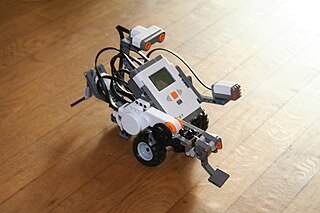
A robot kit is a special construction kit for building robots, especially autonomous mobile robots.
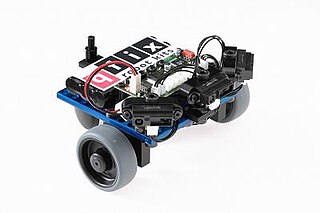
Qfix robot kits are an education tool for teaching robotics. They are used in schools, high schools and mechatronics training in companies. The robot kits are also used by hobby robot builders. The qfix kits are often found in the RoboCup Junior competition where soccer robots are built of the kit's components.

Lego Mindstorms NXT is a programmable robotics kit released by Lego on August 2, 2006. It replaced the first-generation Lego Mindstorms kit, which was called the Robotics Invention System. The base kit ships in two versions: the Retail Version and the Education Base Set. It comes with the NXT-G programming software, or optionally LabVIEW for Lego Mindstorms. A variety of unofficial languages exist, such as NXC, NBC, leJOS NXJ, and RobotC. The second generation of the set, the Lego Mindstorms NXT 2.0, was released on August 1, 2009, featuring a color sensor and other upgraded capabilities. The third generation, the EV3, was released in September 2013.
The Omnibot (オムニボット) is a toy robot originally manufactured by Tomy in the mid-1980s. The name then came to apply to the successful line of robots manufactured by the company. The initial Omnibot was announced with expectations of restoring popular interest in robots, at a time when it was becoming obvious that robots with advanced AI such as R2-D2 were still a long way away. A more advanced version of the Omnibot was called the Omnibot 2000 and did not have a plastic bubble over its head. With the success of the Omnibots, the Omnibot range quickly expanded. After the video game crash of 1983 and its debilitating effect on the nascent home electronics industry, the Omnibot faded away but it was revived in the early 2000s. The latest version of the Omnibot is the i-SOBOT.

FIRST Tech Challenge (FTC), formerly known as FIRST Vex Challenge, is a robotics competition for students in grades 7–12 to compete head to head, by designing, building, and programming a robot to compete in an alliance format against other teams. FIRST Tech Challenge is the one of the four major robotics programs organized by FIRST, which its other three programs include FIRST Lego League Explore, FIRST Lego League Challenge, and FIRST Robotics Competition.

Webots is a free and open-source 3D robot simulator used in industry, education and research.

Omron Adept Technology, Inc. is a multinational corporation with headquarters in Pleasanton, California. The company focus on industrial automation and robotics, including software and vision guidance. Adept has offices throughout the United States as well as in Dortmund, Germany, Paris, France, and Singapore. Adept was acquired by Omron in October 2015.
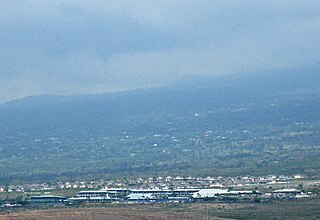
Kealakehe High School is a public high school located in Kailua, Hawaii County, Hawaii, United States. It has the largest geographic school attendance boundary in the state and covers a geographic district 40 miles (64 km) wide, encompassing the communities of Kailua-Kona, Hōlualoa, Waikōloa, and Puakō. The school motto is "Harmony and unity through dynamic education and community for everyone, every time."
The World Robot Olympiad (WRO) is a global robotics competition for young people. The World Robot Olympiad competition uses Lego Mindstorms manufactured by LEGO Education. First held in 2004 in Singapore, it now attracts more than 28,000 teams from more than 85 countries.
The following outline is provided as an overview of and topical guide to robotics:

For Inspiration and Recognition of Science and Technology (FIRST) is an international youth organization that operates the FIRST Robotics Competition, FIRST LEGO League Challenge, FIRST LEGO League Explore, FIRST LEGO League Discover, and FIRST Tech Challenge competitions. Founded by Dean Kamen and Woodie Flowers in 1989, its expressed goal is to develop ways to inspire students in engineering and technology fields. Its philosophy is expressed by the organization as Coopertition and Gracious Professionalism. FIRST also operates FIRST Place, a research facility at FIRST Headquarters in Manchester, New Hampshire, where it holds educational programs and day camps for students and teachers.

Logo Motion is the 2011 FIRST Robotics Competition game. Playing pieces are inner tubes shaped like the components of the FIRST logo. The primary objective of the game is to place them on racks to gain points. In the endgame, robots deploy smaller robots ("minibots") to climb a tower. Minibots must be made from the FIRST Tech Challenge kit of parts. The game celebrates the 20th season of the FRC and is also meant to commemorate the artist Jack Kamen, who designed the original FIRST logo.
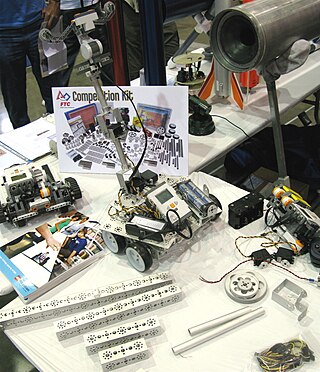
TETRIX Robotics consists of two robotic kits by Pitsco Education. The two sets are the TETRIX® MAX building system and the TETRIX® PRIME building system. They are intended to be used as educational robotics and for competitions such as the FIRST Tech Challenge.
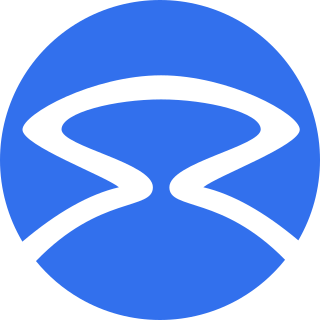
Student Robotics is a registered charity that runs an annual robotics competition for teams of 16 to 19 year-olds. The charity aims to foster a world where engineering and artificial intelligence is accessible to young people with a stated mission "to bring the excitement of engineering and the challenge of coding to young people through robotics". The competition is free to enter and teams are provided with all of the core electronics that they need to build a robot. To encourage creative and ingenious solutions to problems, constraints on design are kept to a minimum, and the students can build and fashion their robots with any materials they choose; this results in a wide range of quirky, original robots. The robots must operate autonomously; once they are switched on to compete no interference from the team is allowed.

Block Party!, released on September 7, 2013, is the 2013–2014 robotics competition for FIRST Tech Challenge. In the competition, two alliances, each consisting of two teams, compete to score blocks in plastic crates atop alliance-colored pendulums. Block Party! is the ninth FTC challenge.
VEX Robotics is a robotics program for elementary through university students, and a subset of Innovation First International. The VEX Robotics competitions and programs are managed by the Robotics Education and Competition Foundation (RECF). In April 2018, VEX Robotics Competition was named the largest robotics competition in the world by Guinness World Records.





















